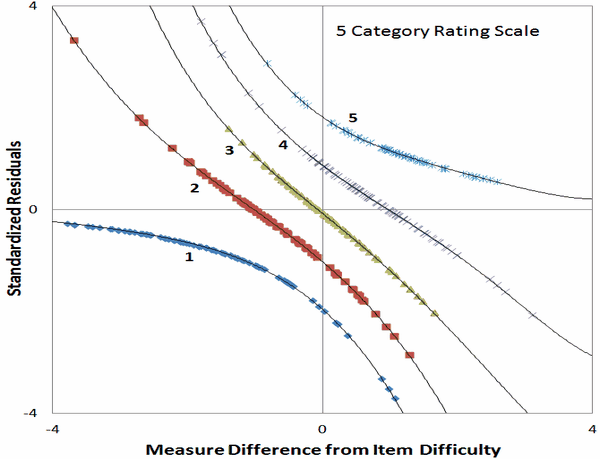
Measures are located on infinite, continuous variables, but they are observed as observations on finite discrete rating (or other) scales. Stephen Humphry (West Australia Writing Assessment, 2002) notices the distinctive patterns of residuals that result.

Figure 1 shows the standardized residuals for observations on a typical 5 category rating scale plotted against measures (relative to the mean difficulty of the item). A residual is the difference between the observation and its expected value for a respondent of a particular ability on that item. The Rasch model also predicts the distribution of observations around their expected value. The residual is divided by the standard deviation of this "model" distribution to obtain the standardized residual.
Each of the distinctive striations in the plot corresponds to the standardized residuals for one of the categories of the rating scale. At each measure, the striations are located at equal vertical intervals, equal in size to the "model" standard deviation. The curvature of the lines is indicative of changes in the item information along the latent variable.

When the standardized residuals for the responses to two items by the same persons are cross- plotted, then distinctive patterns emerge. These are shown in Figure 2. The pairs of responses to the 3- category items are shown on the plot as "response to easy item"+"response to hard item". For each traceline, the lower, left end is generated by high abilities, and the higher, right end by low abilities.
Only 3 instances of the unlikely pairing, "0"+"1" (low rating on the easy item, middle rating on the hard item), are observed. They are in the upper left corner. The most unlikely response pairing, "0"+"2", is not observed here, but would be found in the extreme upper-left corner. The "0"+"0" and "2"+"2" trace lines approach the origin for persons toward the extreme low and extreme high ends, respectively, of the latent variable.
John M. Linacre
Residuals and rating scales. Humphry S. … 16:1 p.866
Residuals and rating scales. Humphry S. … Rasch Measurement Transactions, 2002, 16:1 p.866
| Forum | Rasch Measurement Forum to discuss any Rasch-related topic |
Go to Top of Page
Go to index of all Rasch Measurement Transactions
AERA members: Join the Rasch Measurement SIG and receive the printed version of RMT
Some back issues of RMT are available as bound volumes
Subscribe to Journal of Applied Measurement
Go to Institute for Objective Measurement Home Page. The Rasch Measurement SIG (AERA) thanks the Institute for Objective Measurement for inviting the publication of Rasch Measurement Transactions on the Institute's website, www.rasch.org.
| Coming Rasch-related Events | |
|---|---|
| Jan. 16 - Feb. 13, 2025, Fri.-Fri. | On-line workshop: Rasch Measurement - Core Topics (E. Smith, Winsteps), www.statistics.com |
| Apr. 8 - Apr. 11, 2026, Wed.-Sat. | National Council for Measurement in Education - Los Angeles, CA, ncme.org/events/2026-annual-meeting |
| Apr. 8 - Apr. 12, 2026, Wed.-Sun. | American Educational Research Association - Los Angeles, CA, www.aera.net/AERA2026 |
| May. 15 - June 12, 2026, Fri.-Fri. | On-line workshop: Rasch Measurement - Core Topics (E. Smith, Winsteps), www.statistics.com |
| June 19 - July 25, 2026, Fri.-Sat. | On-line workshop: Rasch Measurement - Further Topics (E. Smith, Winsteps), www.statistics.com |
The URL of this page is www.rasch.org/rmt/rmt161j.htm
Website: www.rasch.org/rmt/contents.htm